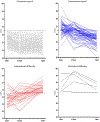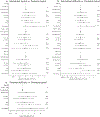Stability of executive function in children born at risk of neonatal hypoglycemia
- PMID: 38010710
- PMCID: PMC11128537
- DOI: 10.1080/09297049.2023.2285391
Stability of executive function in children born at risk of neonatal hypoglycemia
Abstract
Executive function plays an important role in promoting learning and social-emotional development in children. Neonatal hypoglycemia associates with executive function difficulties at 4.5 years, but little is known about the development of executive function over time in children born at risk of neonatal hypoglycemia. We aimed to describe the stability of executive function from early to mid-childhood in children born at risk of neonatal hypoglycemia and its association with neonatal hypoglycemia. Participants in a prospective cohort study of infants born at risk for neonatal hypoglycemia were assessed at ages 2, 4.5, and 9-10 years. We assessed executive function with batteries of performance-based and questionnaire-based measures, and classified children into one of four stability groups (persistent typical, intermittent typical, intermittent difficulty, and persistent difficulty) based on dichotomized scores (typical versus low at each age). Multinomial logistic regression was used to determine the associations between neonatal hypoglycemia and executive function stability groups. Three hundred and nine children, of whom 197 (64%) experienced neonatal hypoglycemia were assessed. The majority of children had stable and typical performance-based (63%) and questionnaire-based (68%) executive function across all three ages. Around one-third (30-36%) of children had transient difficulties, and only a few (0.3-1.9%) showed persistent difficulties in executive function at all ages. There was no consistent evidence of an association between neonatal hypoglycemia and the stability of executive function. Neonatal hypoglycemia does not appear to predict a specific pattern of development of executive function in children born at risk.
Keywords: Self-regulation; infants; longitudinal studies; low blood sugar level; neurocognitive development.
Figures



References
-
- Adamkin DH (2017). Neonatal hypoglycemia. Seminars in Fetal & Neonatal Medicine, 22(1), 36–41. - PubMed
-
- Ahmed FS, & Stephen Miller L (2011). Executive function mechanisms of theory of mind. Journal of Autism and Developmental Disorders, 41(5), 667–678. - PubMed
-
- Anderson P. (2002). Assessment and development of executive function (EF) during childhood. Child Neuropsychology, 8(2), 71–82. - PubMed
Grants and funding
LinkOut - more resources
Full Text Sources
